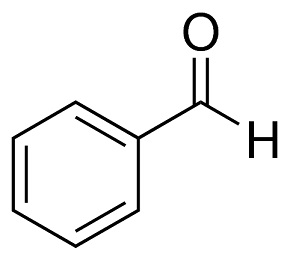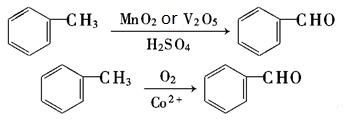Chemical Properties
Benzaldehyde is a colorless to yellow, oily liquid with an odor of bitter almonds.
Benzaldehyde is commercially available in two grades: (i) pure benzaldehyde and (ii) and
double-distilled benzaldehyde. The latter has applications in the pharmaceutical, perfume,
and fl avor industries. Benzaldehyde may contain trace amounts of chlorine, water, benzoic acid, benzyl chloride, benzyl alcohol, and/or nitrobenzene. Benzaldehyde is ignited
relatively easily on contact with hot surfaces. This has been attributed to the property of
very low auto-ignition temperature. Benzaldehyde also undergoes autoxidation in air and
is liable to self-heat. Benzaldehyde exists in nature, occurring in combined and uncombined forms in many plants. Benzaldehyde is also the main constituent of the essential oils obtained by pressing the kernels of peaches, cherries, apricots, and other fruits.
Benzaldehyde is released into the environment in emissions from combustion processes,
such as gasoline and diesel engines, incinerators, and wood burning. It is formed in the
atmosphere through photochemical oxidation of toluene and other aromatic hydrocarbons.
Benzaldehyde is corrosive to gray and ductile cast iron (10% solution), and all concentrations of lead. However, pure benzaldehyde is not corrosive to cast iron. Benzaldehyde does
not attack most of the common metals, like stainless steels, aluminum, aluminum bronze,
nickel and nickel-base alloys, bronze, naval brass, tantalum, titanium, and zirconium. On
decomposition, benzaldehyde releases peroxybenzoic acid and benzoic acidBenzaldehyde is used in perfumes, soaps, foods, drinks, and other products; as a solvent for oils, resins, some cellulose ethers, cellulose acetate, and cellulose nitrate. The uses
of benzaldehyde in industries are extensive. For instance, in the production of derivatives that are employed in the perfume and fl avor industries, like cinnamaldehyde, cinnamyl alcohol, cinnamic acid, benzylacetone, and benzyl benzoate, in the production of
triphenylmethane dyes and the acridine dye, benzofl avin; as an intermediate in the pharmaceutical industry, for instance, to make chloramphenicol, ephedrin, and ampicillin,
as an intermediate to make benzoin, benzylamine, benzyl alcohol, mandelic acid, and
4-phenyl-3-buten-2-one (benzylideneacetone), in photochemistry, as a corrosion inhibitor
and dyeing auxiliary, in the electroplating industry, and in the production of agricultural
chemicals
General Description
A clear colorless to yellow liquid with a bitter almond odor. Flash point near 145°F. More denser than water and insoluble in water. Hence sinks in water. Vapors are heavier than air. The primary hazard is to the environment. Immediate steps should be taken to limit spread to the environment. Easily penetrates the soil to contaminate groundwater and nearby waterways. Used in flavoring and perfume making.
Reactivity Profile
A nontoxic, combustible liquid, reacts with oxidizing reagents. BENZALDEHYDE(100-52-7) must be blanketed with an inert gas at all times since BENZALDEHYDE(100-52-7) is oxidized readily by air to benzoic acid [Kirk-Othmer, 3rd ed., Vol. 3, 1978, p. 736]. In contact with strong acids or bases BENZALDEHYDE(100-52-7) will undergo an exothermic condensation reaction [Sax, 9th ed., 1996, p. 327]. A violent reaction was observed on contact with peroxyacids (peroxyformic acid) [DiAns, J. et al., Ber., 1915, 48, p. 1136]. An explosion occurred when pyrrolidine, BENZALDEHYDE(100-52-7), and propionic acid were heated to form porphyrins.
Air & Water Reactions
Oxidizes in air to form benzoic acid, which is moderately toxic by ingestion. Insoluble in water.
Health Hazard
Exposures to theExposures to the vapor of benzaldehyde cause irritation to the upper respiratory tract,
intolerable irritation of the nose and throat, headache, nausea, dizziness, drowsiness, and
confusion. It is a CNS depressant. Exposures to benzaldehyde cause moderate to severe
eye irritation and prolonged periods of exposure cause corrosive effects to the skin, like
burns, scarring, and skin injury, fatigue, headache, nausea, dizziness, and loss of coordination. At higher concentrations, benzaldehyde produces more severe effects, such as
sore throat, abdominal pain, nausea, CNS depression, convulsions, and respiratory failure.
The estimated lethal dose of benzaldehyde has been reported as 2 oz. There is no data on
humans and the information and conclusions are based on evidence obtained from animal
studies. vapor of benzaldehyde cause irritation to the upper respiratory tract,
Health Hazard
Inhalation of concentrated vapor may irritate eyes, nose and throat. Liquid is irritating to the eyes. Prolonged contact with the skin may cause irritation.
Potential Exposure
In manufacture of perfumes, dyes, and
cinnamic acid; as solvent; in flavors.
Fire Hazard
HIGHLY FLAMMABLE: Will be easily ignited by heat, sparks or flames. Vapors may form explosive mixtures with air. Vapors may travel to source of ignition and flash back. Most vapors are heavier than air. They will spread along ground and collect in low or confined areas (sewers, basements, tanks). Vapor explosion hazard indoors, outdoors or in sewers. Runoff to sewer may create fire or explosion hazard. Containers may explode when heated. Many liquids are lighter than water.
First aid
If this chemical gets into the eyes, remove any
contact lenses at once and irrigate immediately for at least
15 minutes, occasionally lifting upper and lower lids. Seek
medical attention immediately. If this chemical contacts the
skin, remove contaminated clothing and wash immediately
with soap and water. Seek medical attention immediately.
If this chemical has been inhaled, remove from exposure,
begin rescue breathing (using universal precautions, including
resuscitation mask) if breathing has stopped and CPR if
heart action has stopped. Transfer promptly to a medical
facility. When this chemical has been swallowed, get medical
attention. Give large quantities of water and induce
vomiting. Do not make an unconscious person vomit.
Shipping
UN1990 Benzaldehyde, Hazard class: 9; Labels:
9—Miscellaneous hazardous material.
Incompatibilities
The substance reacts with air, forming
explosive peroxides. Reacts violently with performic acid,
oxidants, aluminum, iron, bases, and phenol, causing fire
and explosion hazard. May self-ignite if absorbed in combustible
material with large surface area, or otherwise dispersed
over large areas. Reacts with rust, amines, alkalies, strong
bases, reducing agents such as hydrideds and active metals.
Waste Disposal
Incineration; add combustible
solvent and spray into incinerator with afterburner.
Occurrence
Present as cyanuric glucoside (amygdalin) in bitter almond, peach, apricot kernel and other Prunus
species; amygdalin is also present in various parts of the following plants: Sambucus nigra, Chrysophyllum arlen, Anacyclus
officinarnm, Anacyclus pedunculatus, Davallia brasiliensis, Lacuma deliciosa, Lacuma multiflora and others; free benzaldehyde has been reported found in several essential oils: hyacinth, citronella, orris, cinnamon, sassafras, labdanum and
patchouli. Reported found in strawberry jam, leek (raw) (Allium porrum L.), crispbread, Camembert, Gruyere de Comte,
provolone cheeses, black tea, salted and pickled plum, cooked trassi, Bantu beer, red sage (Texas sage) (S. coccinea Juss. Ex
Murr.), arrack, scallop, hog plum (Spondias mombins L.), chekur (Alpinia sessilis Kon. = Kaemferia galanga) and other natural
sources.
Definition
A
yellow organic oil with a distinct almondlike
odor. Benzenecarbaldehyde undergoes
the reactions characteristic of aldehydes
and may be synthesized in the laboratory
by the usual methods of aldehyde synthesis.
It is used as a food flavoring and in the
manufacture of dyes and antibiotics, and
can be readily manufactured by the chlorination
of methylbenzene and the subsequent
hydrolysis of (dichloromethyl)
benzene:
C6H5CH3 + Cl2 →C6H5CHCl2
C6H5CHCl2 + 2H2O →C6H5CH(OH)2+ 2HCl
C6H5CH(OH)2 →C6H5CHO + H2O.
Preparation
Benzaldehyde is prepared by hydrolysis of benzal chloride, for example, in acidic media in the presence of a catalyst such as ferric chloride or in alkaline media with aqueous sodium carbonate. Part of the commercially available benzaldehyde originates from a technical process for phenol. In this process, benzaldehyde is a by-product in the oxidation, in air, of toluene to benzoic acid.
Aroma threshold values
Detection: 100 ppb to 4.6 ppm; Recognition: 330 ppb to 4.1 ppm.
Taste threshold values
Taste characteristics at 50 ppm: sweet, oily, almond, cherry, nutty and woody
Flammability and Explosibility
Nonflammable
Chemical Reactivity
Reactivity with Water: No reaction; Reactivity with Common Materials: No reactions; Stability During Transport: Stable; Neutralizing Agents for Acids and Caustics: Not pertinent; Polymerization: Not pertinent; Inhibitor of Polymerization: Not pertinent.
Pharmacology
Benzaldehyde significantly inhibited peptic activity in artificial gastric juice in vitro
(20-45% inhibition) and in vivo to the extent of 87% in normal healthy persons and ulcer patients
(Kleeberg, 1959). As a freshly prepared 1:500 solution, it exerted a marked antispasmodic effect,
relaxing the tonus and inhibiting contractions of various isolated smooth muscles of dog, cat, rat,
rabbit, mouse, guinea-pig, pig and frog and of a few human tissues. Injected into rabbits and other
animals it produced a marked relaxation of the intestines and urinary bladder and marked vasodilation
of the splanchnic vessel. Injection of 4 ml of a 5% solution iv into a cat caused a fall in
blood pressure and slowing of respiration. In dogs, 1 ml injected iv or sc or 2 ml/kg given orally
produced only a slight slowing of respiration. Injection of larger doses iv produced only a drop
in blood pressure, slight slowing of respiration and inhibition of intestinal contractions, with vasodilation
of the splanchnic vessel. In rabbits, iv injection of 20 ml of a 0-2% solution did not produce
dangerous results. Large injected doses of benzaldehyde exert their mosjt important toxic effects
on the medulla, with slowing or paralysis of respiration. In the intact animal, the heart is very
little affected; but benzaldehyde acts as a muscular depressant on isolated frog heart (Macht, 1922).
Treatment of isolated rat striated muscle for 1-5 min with 30 mM-benzaldehyde increased the
rate of propagation of contractures and the rate of structural breakdown of injured striated muscle
fibres. After more prolonged application (for 30 min), the rapid propagation of contracture continued
but the structural breakdown was inhibited (Busing, 1972).
Benzaldehyde possessed definite local anaesthetic properties in the sciatic nerves of cats, dogs
and frogs, in the eyes of rabbits and dogs (accompanied by irritation) and in the skin of frogs,
but was considered unsuitable for practical use because of its rapid oxidation to benzoic acid (Macht,
1922).
In a study of the toxic effects of cherry laurel water on mice and on isolated rat intestine, benzaldehyde
was found to aid in the detoxication of HCN by the formation of C6H5?CH(OH)?CN (Lanza
& Conte, 1964).
Benzaldehyde did not act as a cross-linking (tanning) agent for corium and aorta, since in a
015 M solution it did not increase the observed in vitro hydrothermal shrinkage temperatures of
goat skin and human, bovine and canine aortae (Milch, 1965).
The intestinal absorption-rate coefficients of benzaldehyde and related compounds were determined
by perfusion of aqueous solutions through the small intestines of anaesthetized rats (Nogami, Hanano
& Yamada, 1968).
No changes in gastric motor patterns, including gastric motility, were observed in rats after inhalation
of "toxic levels" (not specified) of benzaldehyde from a liquid sample placed in a test chamber
using recirculated air, or from a saturated paper applied to the trachea (Roth & Tansy, 1972).
Benzaldehyde in a concentration of 0-1 mmol/litre caused a 16% depression of the frequency of
electric-organ discharge in the mormyrid electric fish Gnathonemus moori (Walsh & Schopp, 1966).
Synthesis
Natural benzaldehyde is obtained by extraction and subsequent fractional distillation from botanical sources; synthetically, from benzyl chloride and lime or by oxidation of toluene
Metabolism
Benzaldehyde was among 300 volatile constituents detected in the urine of ten adults . It is commonly converted to hippuric acid in vivo. In the rabbit and dog, hippuric acid appears to be the only metabolite there being practically no formation of benzoyl glucuronide. The conversion of benzaldehyde to benzoic acid in the rabbit follows first-order reaction kinetics
Purification Methods
To diminish its rate of oxidation, benzaldehyde usually contains additives such as hydroquinone or catechol. It can be purified via its bisulfite addition compound but usually distillation (under nitrogen at reduced pressure) is sufficient. Prior to distillation it is washed with NaOH or 10% Na2CO3 (until no more CO2 is evolved), then with saturated Na2SO3 and H2O, followed by drying with CaSO4, MgSO4 or CaCl2. [Beilstein 7 IV 505.]
Toxics Screening Level
The initial risk screening level ( IRSL) for benzaldehyde is 0. 4 μg/m3 based on an annual averaging time.







 ;
;